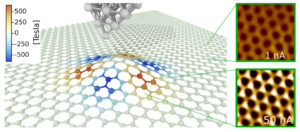
Diagram of symmetrical carbon molecules (Illustration: Peter Nemes-Incze)
By Amanda Biederman
NQPI editorial intern
Distinguishing identical twins can be a difficult task at first. Physics & Astronomy professor and Nanoscale and Quantum Phenomena Institute member Nancy Sandler encounters a similar scenario when dealing with seemingly identical carbon atom pairs.
Sandler recently authored two papers in Nano Letters that described her group’s efforts to characterize the properties of these carbon pairs. The oppositional pairs that comprise the honeycomb sheets of graphene were thought to be indistinguishable at the quantum level, Sandler said. This means the atoms would exhibit identical electron distributions.
“In pristine graphene, one carbon atom is the mirror image of the other,” Sandler said. “They are pretty much like your right and left hand.”
Sandler was intrigued when Marcus Morgenstern, an experimental physicist from RWTH Aachen University, Germany, reported in 2012 that his group had found a way to distinguish the atoms by looking at pairs that are separated from their equilibrium distance.
Two then-visiting graduate students in Sandler’s group, Daiara Faria (from Brazil) and Ramon Carrillo-Bastos (from Mexico), generated mathematical models to characterize charge distributions in graphene. Carrillo-Bastos, who specializes in numeric calculations, simulated the effect of deformation on the paired atoms.
They found that when the surface of graphene was disturbed, the sublattice symmetry was altered, resulting in unequal charge distribution in the pair. Yet the net flow of electrons was unaffected, which explained why charge current distributions had appeared indistinguishable under these conditions. These results were confirmed by analytic models solved by Sandler’s graduate student Dawei Zhai.
“It clicked,” Sandler said. “When the membrane is not strained, there is no way to distinguish one carbon atom from the other. But if you bring it out of the plane, you can see the breaking of this symmetry.”
Sandler collaborated with Morgenstern’s group and used models to characterize the deformations in agreement with experimental data. The second article focused on fold deformations and was written in collaboration with professor Marc Bockrath from Ohio State University. Sandler’s graduate student, Tareq Mahmud, is currently incorporating the effect of electronic interactions.
The group’s work can be used to help researchers better understand the properties of other materials with similar geometries. One idea, Sandler said, would be to predict and describe similar phenomena in molybdenum disulfide that is grown by NQPI colleagues Eric Stinaff and Martin Kordesch using chemical vapor deposition.
“What would the effect of strain be? Can you manipulate mechanically the electrical properties of the material?” Sandler asked. “Because that’s the beauty of it: to control currents using simple mechanical forces.”
This article first appeared in the Nanoscale and Quantum Phenomena Institute Spring 2018 Newsletter #19.



















Comments